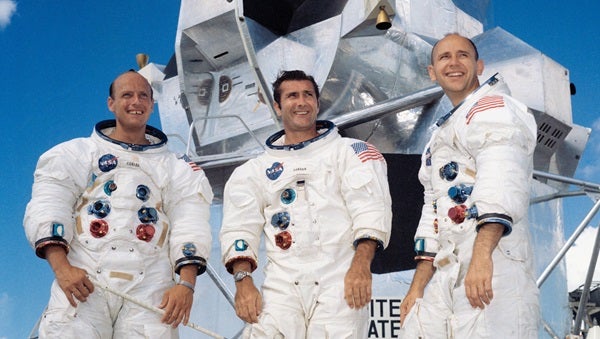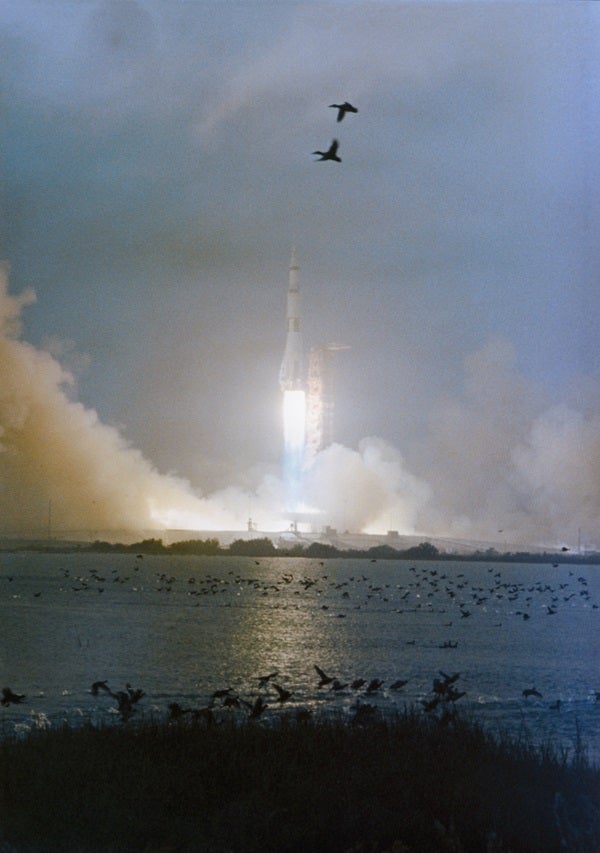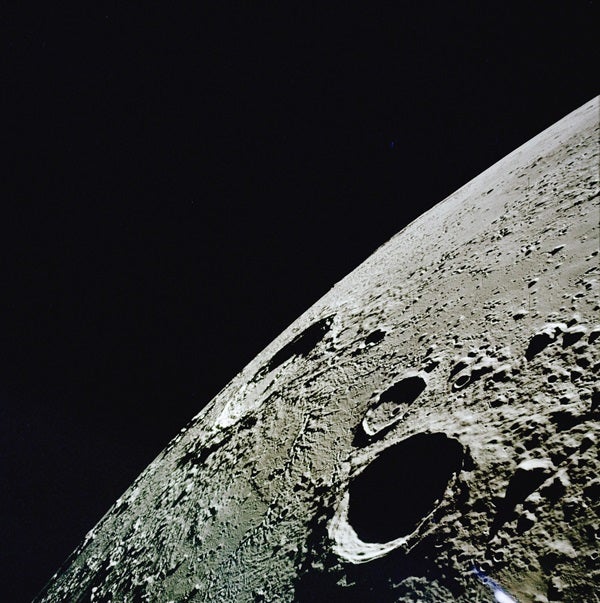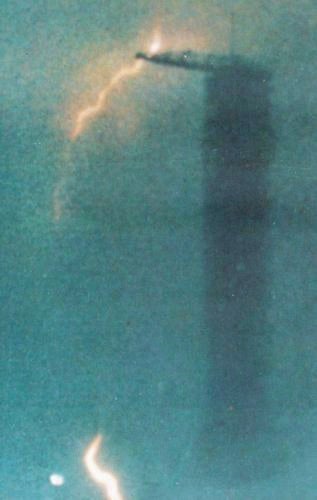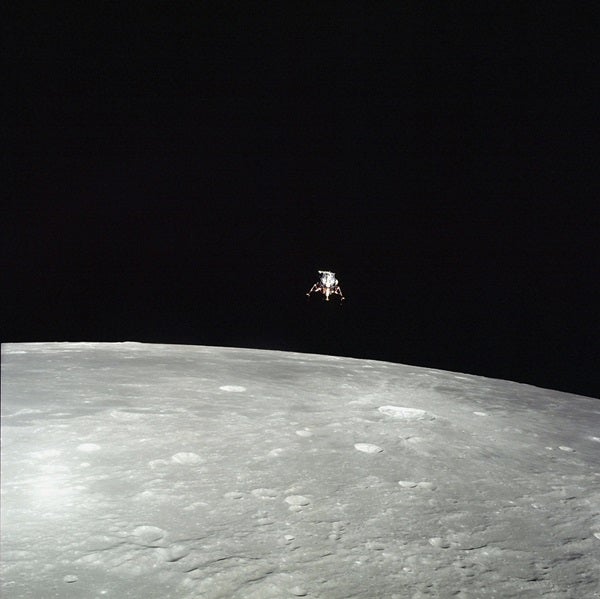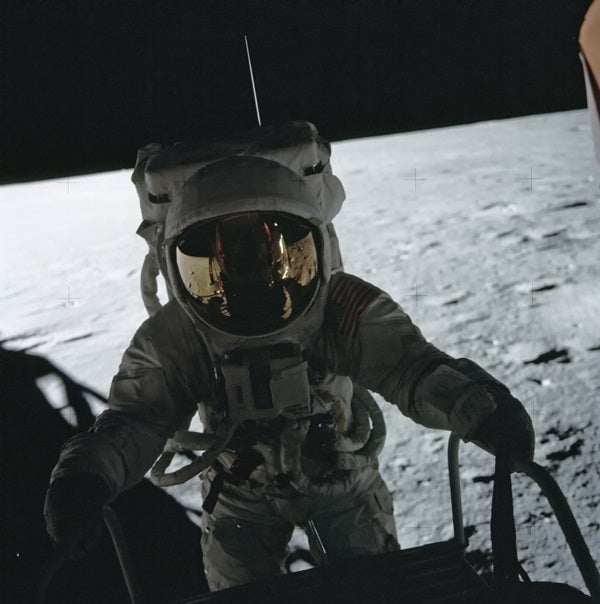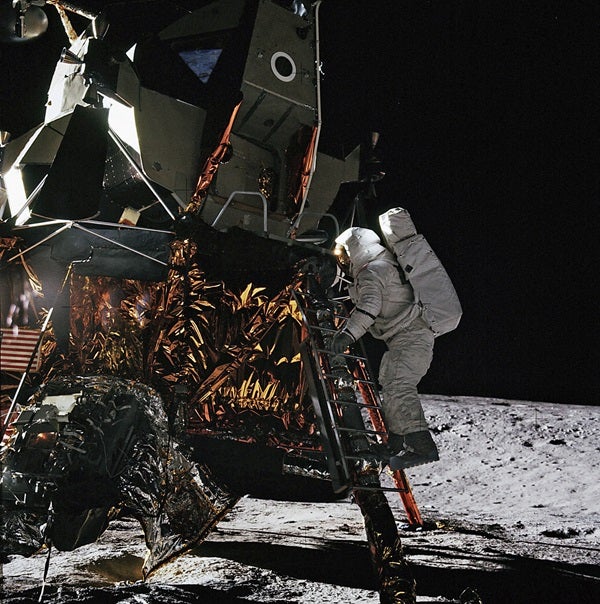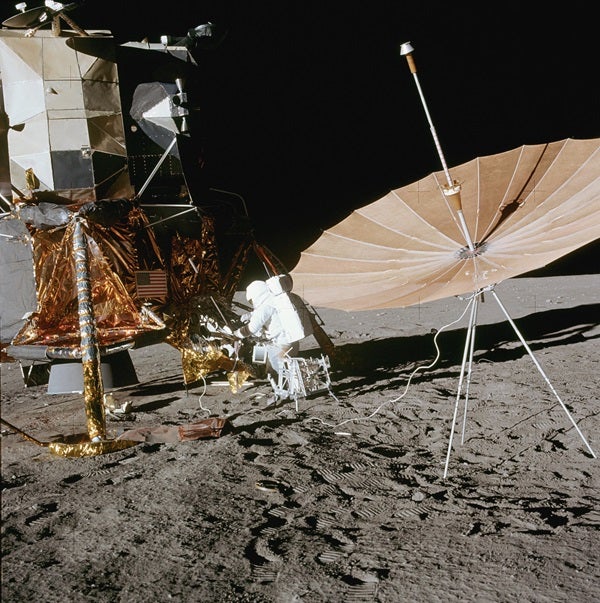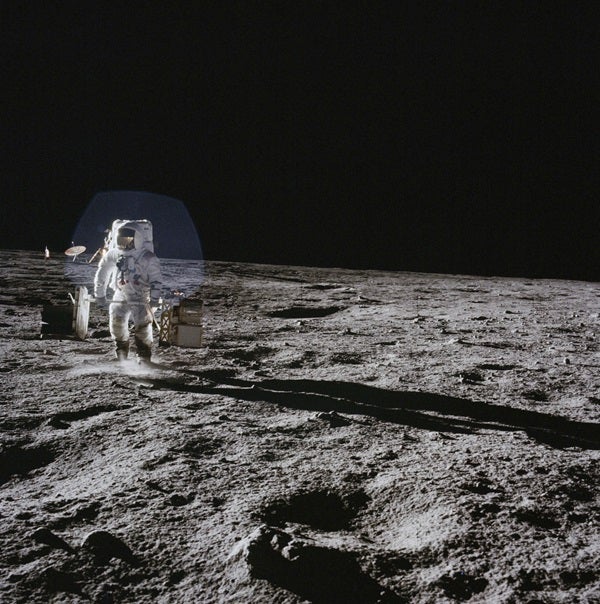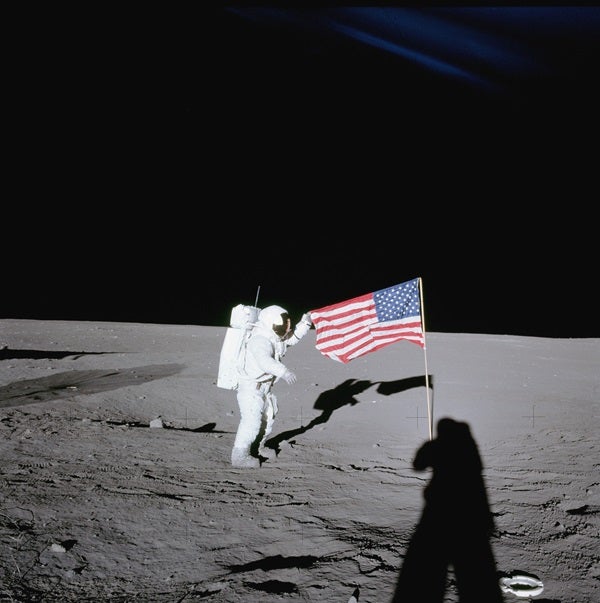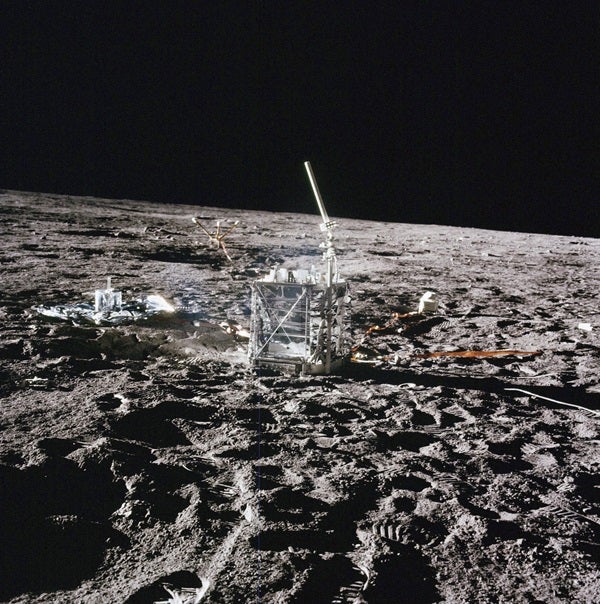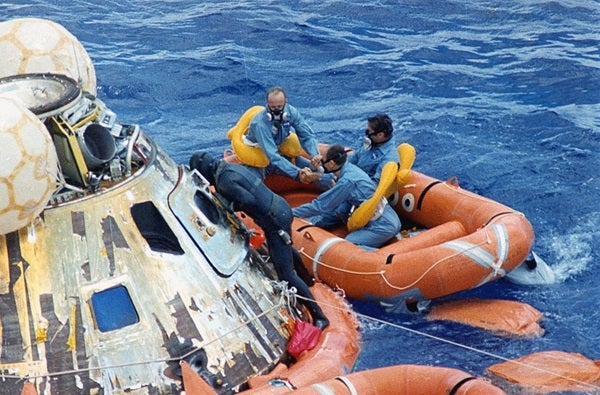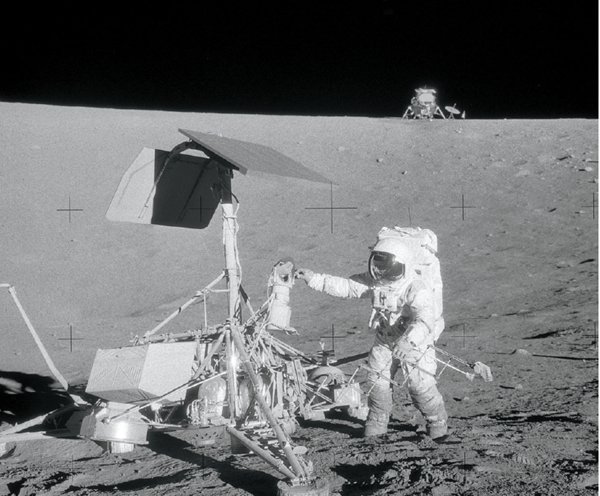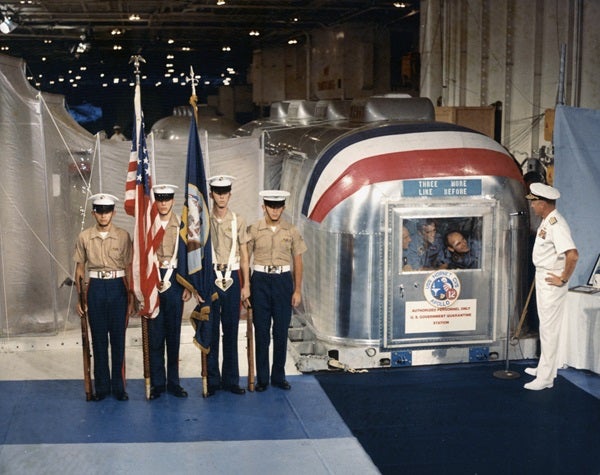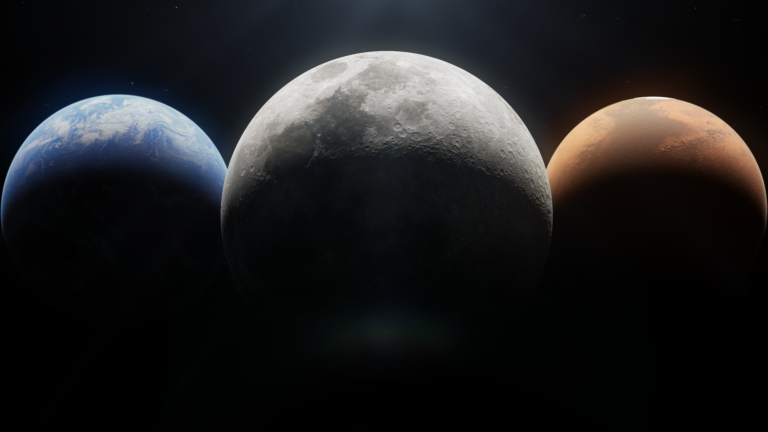Less than a minute after the rocket ignited, however, two unexpected jolts hit the spacecraft. A pair of lightning strikes raised havoc with Apollo 12’s electrical circuits, but the Saturn V continued working flawlessly and got the astronauts into Earth orbit. After checking out the spacecraft and finding no serious permanent damage, the crew set off on a 10-day mission.
NASA had set several ambitious goals for Apollo 12. Perhaps most importantly, the space agency wanted the astronauts to achieve a precision landing in Oceanus Procellarum (Ocean of Storms). Four months earlier, Apollo 11 had missed its target by some 4 miles (7 kilometers); NASA needed precision if it wanted to target scientifically interesting sites in rough terrain. Conrad set down the lunar module, Intrepid, within 600 feet (180 meters) of his objective: the 1967 unmanned explorer, Surveyor 3. Mission accomplished.
During their two moonwalks, Conrad and Bean deployed an advanced suite of scientific instruments, collected 75 pounds (34 kilograms) of rock samples, and retrieved 22 pounds (10 kg) of Surveyor 3 so scientists on Earth could see how the environment affected equipment. The crew also demonstrated that humans could work on the lunar surface for several hours at a stretch — a key demand for the even more ambitious Apollo missions to come.
Everything seemed set for a perfect liftoff. Everything, that is, except the weather. A front that started passing through Florida’s Kennedy Space Center late November 13 had slowed unexpectedly and seemed destined to stick around through the planned 11:22 a.m. EST launch. But the conditions — cloud tops at about 23,000 feet (7,000 m) and low turbulence — were within NASA’s constraints. The Saturn V rocket ignited right on time, and Apollo 12 began its slow ascent.
The CapCom (capsule communicator) during the first part of the flight was astronaut Gerald Carr, who would command the third and final crewed mission to Skylab between November 1973 and February 1974. We pick up the conversation between the astronauts and the ground starting 20 seconds into the flight.
Conrad: It’s a lovely liftoff. It’s not bad at all.
Gordon: Everything’s looking great. Sky’s getting lighter.
Conrad: OK.
Bean: 30 seconds.
Conrad: Looks good.
Conrad: Roll’s complete.
Bean: This thing moves, doesn’t it?
Carr: Roger, Pete. [Pause]
Conrad: Roger. We [garbled] on that. [Long pause.]
Bean: There’s nothing — it’s nothing …
Gordon: A circuit …
Conrad: Where are we going?
Gordon: I can’t see; there’s something wrong.
Conrad: AC Bus 1 light, all the fuel cells …
The second lightning strike hits the spacecraft 52 seconds into the flight, causing the command module’s guidance platform to lose its reference and begin to tumble.
Conrad: I just lost the platform.
Bean: [Garbled.] Got your GDC [Gyro Display Coupler].
Conrad: OK, we just lost the platform, gang. I don’t know what happened here; we had everything in the world drop out.
Conrad: I got three fuel cell lights, an AC bus light, a fuel cell disconnect, AC bus overload 1 and 2, Main Bus A and B out. [Long pause.]
Bean: I got AC.
Conrad: Maybe it’s just the indicator. What do you got on the main bus?
Bean: Main bus is — the volt indicated is 24 volts.
Conrad: Huh?
Bean: 24 volts, which is low.
Conrad: We’ve got a short on it of some kind. But I can’t believe the volt …
Carr: Apollo 12, Houston. Try SCE [Signal Conditioning Electronics] to auxiliary. Over.
Conrad: Try FCE [sic] to auxiliary. What the hell is that?
Carr: SCE, SCE to auxiliary. [Long pause.]
Conrad: Try the buses. Get the buses back on the line.
Bean: It looks — everything looks good.
Conrad: SCE to aux.
Gordon: The GDC is good.
Conrad: Stand by for the — I’ve lost the event timer; I’ve lost the …
Carr: Mark. One Charlie.
Conrad: One Charlie.
Gordon: 2 minutes. EDS [Emergency Detection System], auto, is off.
Conrad: Yes.
Conrad: EDS, auto …
Gordon: What do the buses read, Al?
Bean: Stand by.
Conrad: Inboard engines.
Gordon: OK.
Carr: Apollo 12, Houston. Try to reset your fuel cells now. [Long pause.]
Bean: Reset the fuel cells.
Gordon: Wait for staging.
Conrad: Wait for staging, yes.
Gordon: Hang on.
Conrad: Hang on.
Conrad works to latch a rock box to the Modular Equipment Stowage Assembly. The astronauts used the large antenna at right for communications with Earth.
Conrad works to latch a rock box to the Modular Equipment Stowage Assembly. The astronauts used the large antenna at right for communications with Earth.
Bean: Yes. Hang on.
Gordon: There’s 41. Hang on, there it is.
Bean: That’s it.
Conrad: That’s it.
Bean: Staging.
Gordon: Hang on.
Conrad: OK, GDC is good.
Conrad: Got a good S-II [second stage], gang.
Carr: Roger. We copy, Pete. You’re looking good.
Bean: Cabin pressure’s OK.
Gordon: We’re OK.
Conrad: OK. Now we’ll straighten out our problems here. I don’t know what happened; I’m not sure we didn’t get hit by lightning.
Carr: Your thrust is looking good, Pete.
Conrad: OK. I have a good GDC, and Al has got the fuel cells back on, and we’ll be working on our AC buses.
Carr: Right, Pete. Your fuel cells look good down here.
Bean: Everything looks good.
Gordon: Stand by.
Conrad: Think we need to do a little more all-weather testing.
Carr: Amen.
After reaching orbit, the astronauts verified the spacecraft’s health. The crew fired the engine to escape Earth orbit and embarked on an uneventful three-day journey to the Moon, entering lunar orbit the evening of November 17.
After spending a day circling the Moon, Conrad and Bean entered the lunar module for their descent to the surface, while Gordon stayed behind in the command module, Yankee Clipper. We pick up the conversation between the Intrepid crew and the ground starting about four minutes before touchdown.
Carr: Intrepid, Houston. You’re looking good at eight [minutes].
Bean: OK; passing 12,000 feet …
Carr: Roger.
Bean: Spring-loaded to go grab that Surveyor.
Once they pass through 10,000 feet, they initiate P64, one of three computer programs the astronauts used during the descent. P63 performed the first braking maneuver, P64 handled the approach phase when Conrad got his first good look at the landing site, and P66 turned control over to Conrad to manually land the lunar module.
Conrad: I’m trying to cheat and look out there. I think I see my [Surveyor] crater.
Bean: [Garbled.]
Conrad: I’m not sure.
Bean: Coming through seven [thousand feet]. P64. P64, Pete.
Conrad: P64.
Bean: Pitching over.
Conrad: That’s it; there’s LPD [Landing Point Designator; a control that allowed the pilot to designate a new target site].
Conrad: Hey, there it is! There it is! Son of a gun! Right down the middle of the road!
Bean: Outstanding! 42°, Pete.
Conrad: Hey, it’s targeted right …
Bean: 42.
Conrad: … for the center of the crater!
Bean: Look out there.
Conrad: I can’t believe it!
Bean: Amazing! Fantastic! 42°, babe.
Conrad: Just keep talking.
Bean: Guide it in. 42; we’re passing 3,500. Coming down at about 99 feet a second. You’re looking good. Got 15 percent fuel [left]; I’ll reset my watch.
Carr: Intrepid, Houston. Go for landing.
Conrad: OK; I’m going to click over one. I just want LPD to the right a little.
Bean: [Responding to Carr.] Roger.
Conrad: OK. Roger.
Bean: 40°, LPD, Pete; 40°.
Conrad: That’s so fantastic, I can’t believe it!
Bean: You’re at 2,000 feet.
Conrad: How far?
Bean: The boys on the ground do OK. 1,800 feet up, 39°; you got 94 seconds of LPD time left.
Conrad: OK. I want to move [the landing point] forward a little bit.
Bean: 38°. 36°; you’re 1,200 feet, Pete. A thousand feet coming down at 30 [feet per second]. You’re looking good. Got 14 percent fuel. [Glancing out the window.] Looks good out there, babe. Looks good! 32°. You’re at 800 feet. 33°. You’re at 680 feet. 33°, 600 feet. Antenna’s OK.
Conrad: I got it.
Bean: 400. You’re in P66, Pete.
Conrad: Right.
Bean: P66. OK.
Conrad: Yeah. I got to get over to my right.
Bean: You’re at 330 feet, coming down at 4.
Conrad: Yeah.
Bean: You got 11 percent. Got loads of gas. 300 feet, coming down at 5 [feet per second].
Conrad: Gosh, I went by it.
Bean: Hey! Look at that crater; right where it’s supposed to be! Hey; you’re beautiful. 10 percent [fuel remaining]. 257 feet, coming down at 5; 240 coming down at 5. Hey, you’re really maneuvering around.
Conrad: Yeah.
Bean: Come on down, Pete.
Conrad: OK.
Bean: 10 percent fuel. 200 feet; coming down at 3. [You] need to come on down.
Conrad: OK.
Bean: 190 feet. Come on down. 180 feet; 9 percent [fuel remaining]. You’re looking good. Going to get some dust before long. 130 feet; 124 feet, Pete. 120 feet, coming down at 6. … You’re looking good. 70 feet; looking real good. 63 feet. 60 feet, coming down at 3.
Bean: 50 feet, coming down; watch for the dust.
Conrad: Yeah.
Bean: 46 [feet].
Carr: Low level [fuel warning].
Bean: 42 feet. Coming down at 3. Coming down at 2. OK. Start the clock. 42 feet, coming down at 2. 40, coming down at 2. Looking good; watch the dust. 31, 32, 30 feet. Coming down at 2, Pete; you got plenty of gas, plenty of gas, babe. Hang in there.
Carr: 30 seconds [fuel left].
Bean: 18 feet, coming down at 2. He’s got it made! Come on in there. 24 feet.
Bean: Contact light.
Carr: Roger. Copy contact.
As he made his second post-landing pass, he thought he saw something near the Snowman formation, a distinctive group of craters that resembles a snowman. (Surveyor Crater represents the Snowman’s tubby torso.) In this exchange, he converses with CapCom Ed Gibson, who would fly with Carr on Skylab.
Gibson: Say, Dick, when you’re looking for them in the sextant, if you look at the Head Crater, we suspect that they’re on the northwest rim of Head Crater. That’s the Head of the Snowman.
Gordon: OK. Understand.
Gordon: Houston, I have Snowman. And I believe I have the Surveyor from the northwest side of the Surveyor Crater.
Gibson: Clipper, Houston. We copy that …
Gordon: And, Houston, it’s cast a shadow; it looks like it is about — oh, it’s hard to distinguish; it looks like about a third of a crater in diameter.
Gibson: Roger, Clipper. Copy you.
Gordon: I have. I have Intrepid. I have Intrepid.
Gibson: Well done, Clipper. Copy; one crater diameter to the north. Is that affirmative?
Gordon: I have him. He’s on the Surveyor Crater; he’s about a fourth of a Surveyor Crater diameter to the northwest.
Gibson: Roger.
Gordon: He’s got a fairly good-sized crater just to the north and slightly east of him; out directly behind him; he is on the Surveyor Crater.
Gibson: Roger, Clipper. [Long pause.]
Gordon: All right, Ed. Now I’m directly overhead. He’s a third of the way between the Surveyor Crater and the Head.
Gibson: Clipper, Houston. Say again.
Gordon: The Intrepid is just on the left shoulder of the Snowman. He is looking at me. He is about a third of the way from the Surveyor Crater to the head. I see the Surveyor! I see the Surveyor!
Gibson: Roger, Clipper. Good eyeball. Well done.
Gordon: Hey, Ed. That’s almost as good as being there.
——————————
Less than five hours after Intrepid set down, Conrad opened the hatch, climbed down the ladder, and stepped onto the surface. Bean followed a half-hour later. The astronauts collected samples and set up the Apollo Lunar Surface Experiments Package (ALSEP), a more advanced suite of instruments than the one Apollo 11 took to the Moon four months earlier.
They accomplished most of their tasks quite easily, though Bean accidentally broke the color TV camera when he pointed it directly at the Sun. The two also ran into a problem when they tried to remove the plutonium fuel needed to power the experiments from its protective cask. Here’s how they solved that issue.
Conrad: Hey, I’ll be with you.
Bean: … Go get that hammer and bang on the side of it.
Conrad: No. I got a better idea. Where’s the hammer?
Bean: That’s what I said.
Conrad: No, no. But I want to try and put the back end in under that lip there and pry her out. Let me go get the hammer. Be right back. Where did you put it?
Bean: Huh? What? Hammer’s on the MESA [Modular Equipment Stowage Assembly].
Conrad: OK.
Bean: Let me get the tool off; it’s starting to warm up.
Conrad: OK.
Bean: Can’t figure that out. [Pause.]
Gibson: Al, when you’re working on that, try to make sure you’ve got the pins all the way in. Tighten up on it; then you can try pushing down on it a little, before you pull it out.
Bean: OK. [To Pete.] Don’t touch these needles [the pins on the removal tool]; if these break off, that’s all she wrote.
Conrad: No, no. I’m not going to.
Bean: OK. We’ll try again. Rotate and try it this way. [The removal tool] drives in there just like it’s going to do the job. Only it doesn’t do the job.
Conrad: Oh man, look at this dust fly.
Bean: Just a minute. Just a minute. [Let me] get those pins in there again.
Conrad: You’re not getting those pins all the way in.
Bean: They’re not in now because I’m lining them up. Just a damn minute. Now they are all the way in. They’re all the way … Not quite. That bottom one down there’s … Now, my recommendation would be pound on the casket, then … You know.
Conrad starts hitting the side of the cask with the flat of the hammer.
Bean: Hey, that’s doing it! Give it a few more pounds. Got to beat harder than that. Keep going. It’s coming out. It’s coming out! Pound harder.
Conrad: Keep going.
Bean: [Laughs, cheering him on.] Come on, Conrad!
Conrad: Keep going, baby.
Bean: That hammer’s a universal tool.
Conrad: You better believe it.
Bean: There, you got it!
Conrad: Got it.
Bean: Got it, Houston. [Conrad laughs.] That’s beautiful. That’s too much.
Gibson: Well done, troops.
Bean: Don’t come to the Moon without a hammer.
As the astronauts approached the Surveyor, they were startled to find that the probe — bright white when it left Earth — had turned light brown. They ultimately deduced that Intrepid’s descent engine had kicked up some fine dust during the landing. In this brief snippet, Conrad and Bean examine the mirrored glass surface on the top of Surveyor 3.
Conrad: OK. Now be careful about the glass.
Bean: Yeah; I’ll be careful. Let me look and see what it looks like. Houston, not a bit of this glass is cracked. One little piece down here looks like it no longer reflects, but other than that, it’s in perfect condition. A little warped — [some] segments warped — but, other than that, it looks pretty much the same [as the mock-up used in training]. The thing that’s the most amazing to me is how it’s turned so brown!
Gibson: Roger. We copy that, Al.
Bean: I’m going to wipe it, but not with my glove. I’m going to wipe it with this little cloth that protects my wrist ring. It doesn’t have anything structurally associated with it. [Bean does this to protect his suit from cuts and any corrosive agents the Surveyor engine’s exhaust deposited on the mirrors.]
Bean: Let me wipe a couple of spots, though it might … It’s going to be tough to show this, Pete. It’s in a shadow. Give it a go, though. I don’t think the pictures are going to show you much, Houston. Because it’s … Well, we’ll give it a go, but …
Conrad: They’re better than no pictures at all.
Bean: That’s right. That’s exactly right.
——————————
After two excursions and 7 hours 45 minutes on the lunar surface, Conrad and Bean left their temporary home and rejoined Gordon on Yankee Clipper. Intrepid’s ascent engine fell back to the Moon, and the ALSEP seismometer recorded vibrations from the impact lasting for more than an hour.
The crew lit Apollo 12’s main engine one last time November 21 to bring them back to Earth. They landed in the South Pacific Ocean on the 24th and were picked up by the USS Hornet. Although Gordon never flew in space again, both Conrad and Bean got one more shot at glory as commanders of separate Skylab missions. But, it’s safe to say, Apollo 12’s spectacular success was the highlight of their NASA careers.

